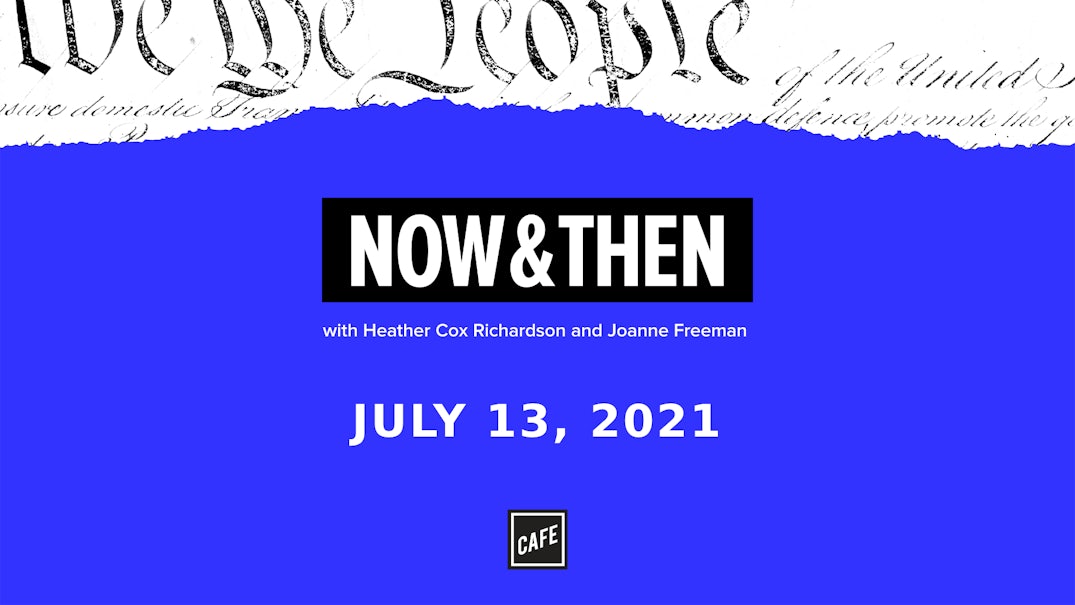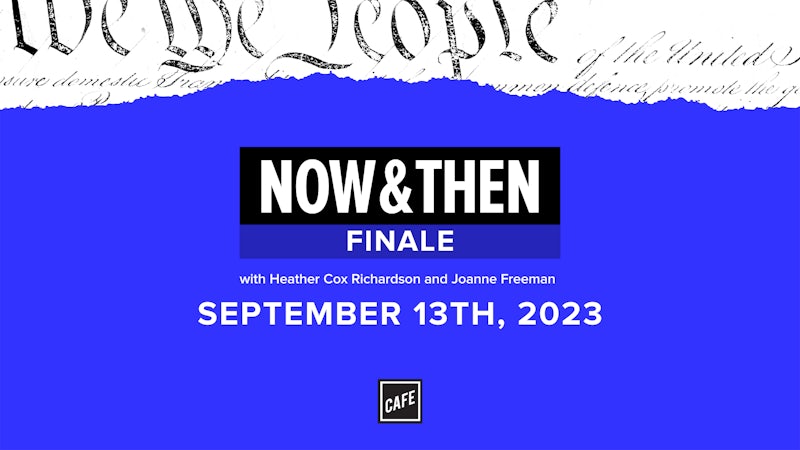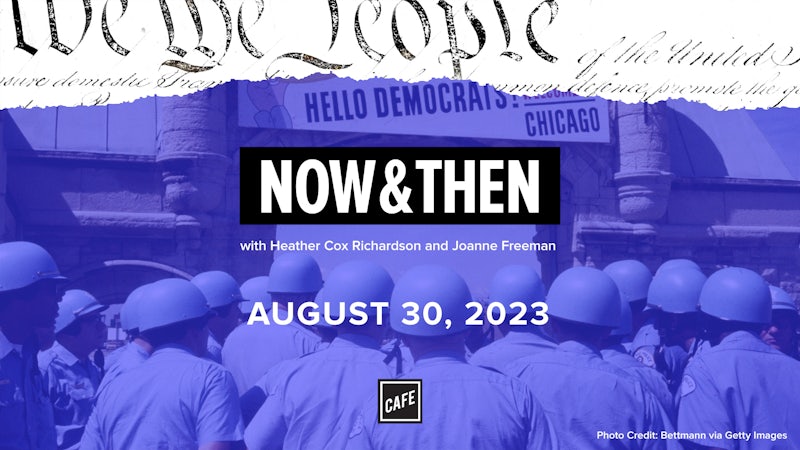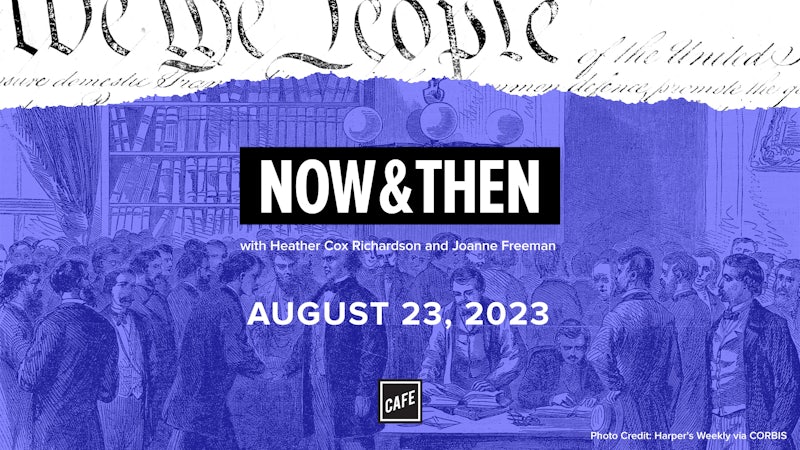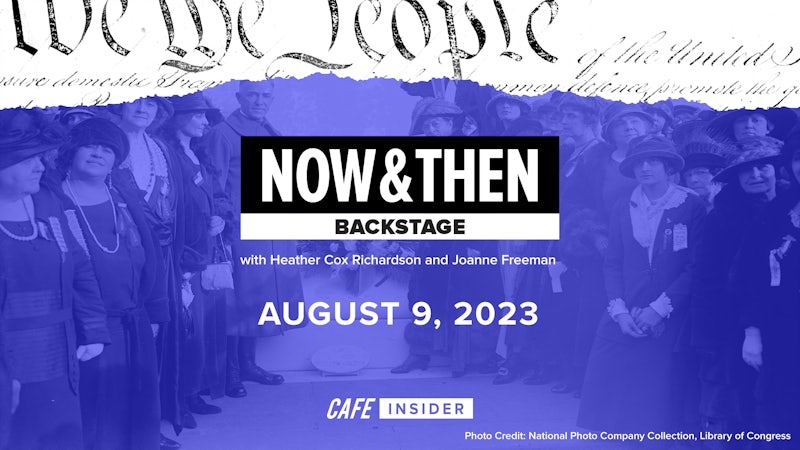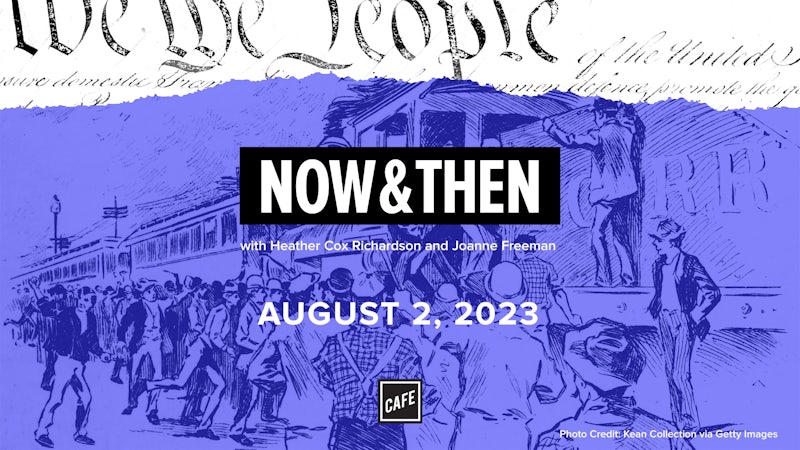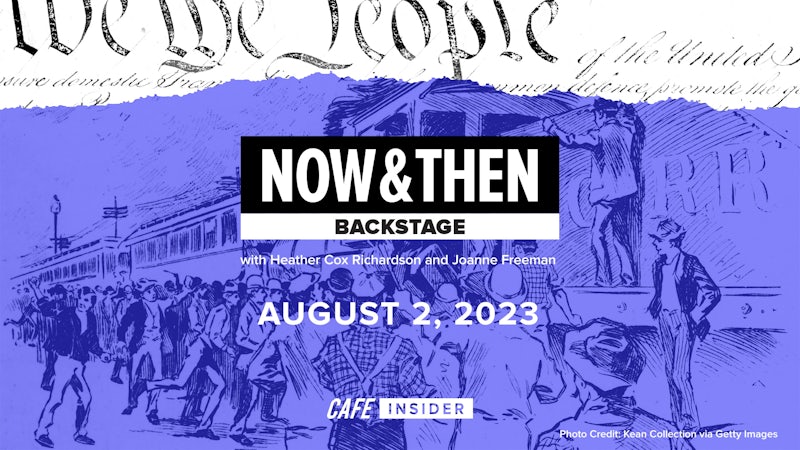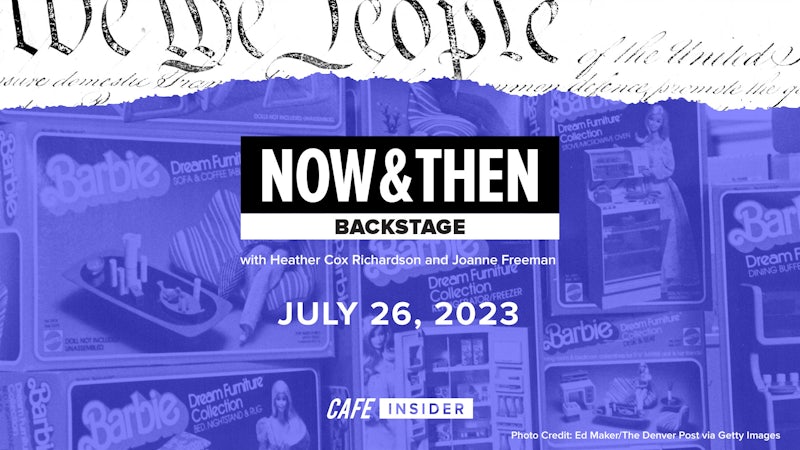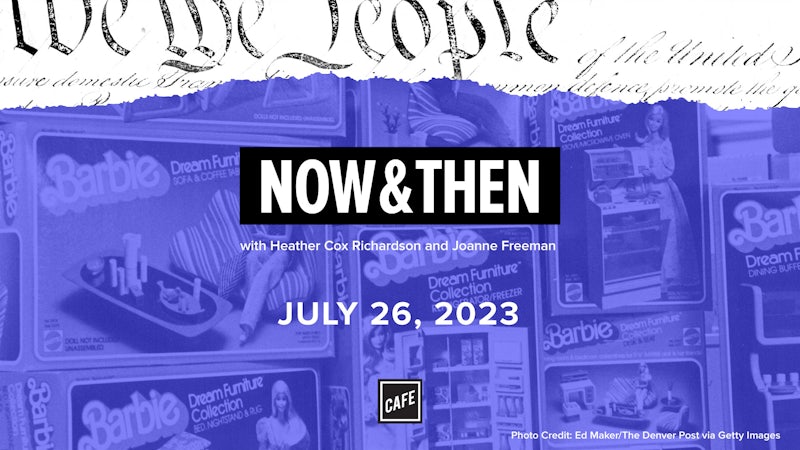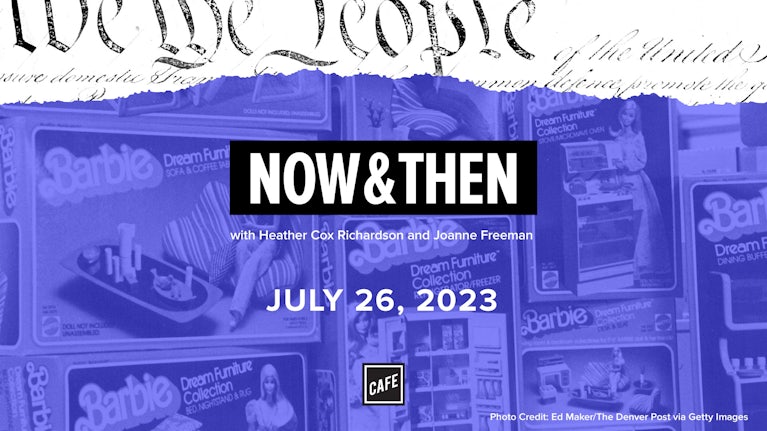Heather Cox Richardson:
From Cafe and the Vox Media Podcast Network, this is Now and Then. I’m Heather Cox Richardson.
Joanne Freeman:
And I’m Joanne Freeman. Before we get started, we wanted to let you know that we are inviting you to a live taping of our next Now and Then episode, this Thursday, July 15th at 6:30 PM Eastern Time. You can RSVP at cafe.com/live, and also you can watch it live on Cafe’s Twitter and Facebook pages, and Heather’s Facebook page. Okay. Now that we’ve gotten that little promotional announcement out of the way, and you really should come because it’s going to be fun.
Now, let’s get to the topic at hand, the Supreme Court. Now, we chose the Supreme Court for obvious reasons. It’s been in the news. This session of the court has just ended, and it ended with a couple of decisions that obviously for good reason, have attracted a lot of notice. And what we really wanted to do today is put this court in context, to look at other courts in the past, to look at what they did and to talk in a broader way about what the Supreme Court does for the nation, and I suppose in one way, the many ways in which the Supreme Court in its rulings basically shows a vision and promotes a vision of what America should be.
Heather Cox Richardson:
And it was interesting when we decided to talk about this, that unlike everything else we’ve talked about in our history together, we both found the Supreme Court a funny topic in that we both know it really well, and we know a lot of decisions, and we teach a lot of decisions. But talking about the role of the Supreme Court in American history proved to be the hardest concept that we’ve tried to grapple with together. We spent more hours trying to put this episode together than any of the others, I don’t think, and almost than any of the others combined, but we were going.
Joanne Freeman:
No, totally true. Over the course of two and a half days, three conversations. No. And it’s, one of the things that I said as you and I were talking back and forth to each other, Heather was, in the various things that I do in the public, what people always want to know more about is the Supreme Court. And that’s not necessarily just because they’re interested in the court, but I think it’s something that people uniformly don’t know a lot about, don’t know how to think about it, aren’t necessarily absolutely sure what it’s supposed to be doing versus what it is doing now. So, in a way I found our casting about like, how do you want to approach this? I’m not sure, as a reflection of how hard it is to generalize and think about the court, particularly given what we’re going to be talking about today, which is the ways that it changes over time.
Heather Cox Richardson:
So, I got to do what everybody in the country wants to do. I got to go to a scholar of early America and say, “So, what did the framers actually want to do when they up a Supreme Court?” And then she said, “Well, let’s read the transcripts.” Which we did. Go for it, Joanne.
Joanne Freeman:
I did. I was like, “Well, come on, we can read what people said at the Federal Convention during the debates.” I went back and re-read some of the Federalists essays by Hamilton, right? They will tell us what they thought. And actually, particularly in the Federalist essays, since in those essays, Hamilton was partly explaining this new constitution or this new wannabe constitution and partly defending it. He talks a lot about the court and in a sense, defends it because clearly fear on the part of a lot of people was that it was going to be extremely powerful, that a small group of men was going to assert their will over the will of the people in the other branches of government.
So, Hamilton holds forth and tries in a variety of ways to show how the court really isn’t that strong. And he says, among other things, that judiciary has no influence over either the sword or the purse, no direction, either of the strengths or of the wealth of the society, and could take no active resolution, whatever. It may truly be said to have neither force nor will, but merely judgment, and must ultimately depend upon the aid of the executive arm, even for the efficacy of its judgments.
And then summing it all up, he said, incontestably, the judiciary is beyond comparison the weakest of the three departments of power. So, the idea behind the Supreme Court was that it would be above the fray. It would be indeed a small group of people, but it would be a small group of people put in office for life during good behavior in parts, so that they would not have to worry about the comings and goings of political parties. And that in that role, they would be able to think more broadly about the country and to think more broadly about the constitution, and in a way not be swayed by the upsets of democracy.
Heather Cox Richardson:
And I love the idea that this is of course, before the idea of they’re going to be political parties at all, but that these are supposed to be people, of course, white men is what they’re thinking of at the time, who are above the fray. They’re statesmen, if you will, who are going to have a broad look at what the country really should be about, but there’s no requirement that they’re lawyers. There’s no requirement that they’re politicians. There’s no requirement that they’re anything other than sort of the town fathers, if you will. Is that right?
Joanne Freeman:
Well, it is, but with one qualification, and that is despite everything I just said about being above the fray, the founders weren’t a bunch of naive guys. They had a lot of issues, but probably naivety wasn’t one of them. So, they’re not assuming that whoever they put in that office does not have political preferences. They’re assuming that whoever is in there has principles and preferences, and ideology. They’re just assuming that the people in that office, and as you’re saying, pretty wide spectrum of people could be justices depending on what the Senate and what the president think. But they are assuming that regardless of their personal inclinations, that they will be able to have this broader kind of a view.
Heather Cox Richardson:
This broader judgment. And so, the idea that the Supreme Court is going to be this arbiter, if you will, of what’s good for America, obviously doesn’t play out through history. We end up and we’re going to be talking today about some courts that don’t end up with that kind of a reputation and how exactly that happens. But maybe it’d be more fun to walk through how courts become different by starting with the first really dramatic court in American history. And that’s John Marshall’s court.
And I have the reason, I guess, I’m jumping ahead to Marshall is because the story of how John Marshall became the Chief Justice of the Supreme Court is to my mind one of the more endearing stories of American history. And I did not know it until we were talking about John Marshall. And probably most people know the name, John Marshall, as being the one of the real early Americans who developed the parameters of the American government. But I guess, I’ve always thought of him as being this larger than life figure. And there was this we’re going to put John Marshall on the court. And that’s not at all what happened.
Joanne Freeman:
No, that’s not at all what happened. And it’s worth saying, we’ll be talking about Marshall, and really talking about him as a figure who becomes important for adding strength to the court. The story I’m about to tell is in line with this early court, which met initially only a few weeks out of the year. I think there were, I don’t know, less than 50 cases heard in the first 10 years. It was really not the Supreme Court in all capital letters that we perceive it today. It was not seen as a very important job.
And actually the first Chief Justice, John Jay, ultimately resigns, he’s asked to come back under Adams to be the Supreme Court, Chief Justice again. And he says, no, because the Supreme Court doesn’t have enough weight and dignity as a branch of government for him to really want to do that anymore. And when he decides to be governor of New York, he runs for governor and wins, that’s seen as a promotion. Oh, okay, well, he’s leaving the Supreme Court. Now, he really has a job, he’s going to be governor.
So, Adams is trying to figure out towards the end of his term, who this new Chief Justice who’s going to be. Jay has said, no. He thinks maybe William Patterson. And Marshall, John Marshall comes in to Adams’ office with in his hand, John Jay’s letter declining the appointment and saying, “I just don’t think the job has enough dignity, the court has enough dignity.”
So, what I’m going to read is a few sentences actually from a letter that Marshall himself wrote. “When I waited on the president with Mr. Jay’s letter, declining the appointment, he said, thoughtfully, “Who shall I nominate now?” I replied that I could not tell as I suppose that his objection to Judge William Patterson remained. He said, in a decided tone, “I shall not nominate him.” After a moment’s hesitation he said, “I believe I must nominate you.” I had never before heard myself named for the office, and had not even thought of it. I was pleased, as well as surprised, and bowed in silence. Next day, I was nominated.”
It’s a story that I knew and I told to Heather and she laughed. And then I thought, “Oh, I better back it up.” So, finding it in Marshall’s own words as a historian, that’s quality evidence.
Heather Cox Richardson:
I just love that John Marshall, who goes on to be John Marshall is like, “Hey, air in the room, you can fog a mirror. How about you become Chief Justice?” What year is that he becomes Chief Justice?
Joanne Freeman:
In 1801.
Heather Cox Richardson:
So, 1801, the country is just trying to figure out what, in fact the government is supposed to be doing. And he sets out to determine that.
Joanne Freeman:
Right. And so, in contrast with what the court was before that point, so that Jay could decide it was not important enough for him to take that job, Marshall really completely alters the nature of the Supreme Court in a very deliberate way. He’s the longest serving Chief Justice in American history. He served from 1801 to 1835, which is a pretty amazing stretch.
Heather Cox Richardson:
Especially in those days.
Joanne Freeman:
Yeah. Well, from John Adams to Andrew Jackson, I mean, that’s pretty amazing. So, Marshall does two main things during his tenure as Chief Justice. On the one hand, he is dealing repeatedly, and for good reason, given how new the nation is with questions of things like interstate commerce or contracts. And are contracts binding kind of state, basically back away in some way from a contract, are they binding? What role does the court have in that? What role does the court have really in a variety of different interstate issues and business-related issues on a state level?
And again, and again, and again, Marshall is basically saying, “Okay. Here’s another ruling that says, yes, the court, the Supreme Court has the ability to make this decision.” One of his early really important decisions is Marbury V Madison in 1803. So, Adams is leaving office as president. He wants to plant all of these judges into a variety of different courts around the country to implant the Federalist Party. William Marbury is one of those appointments. He is appointed justice of peace for the District of Columbia. His appointment is not delivered to him. Madison does not ultimately under Jefferson delivery because Jefferson tells him to hold back on the appointment. And this ends up going to the Supreme Court because Marbury says, “I deserve that job. I deserve that appointment and I’m appealing it to the court.” And actually, here’s what’s interesting about that is that the person who was dealing with the appointment of these justices was Marshall, who was secretary of state for Adams.
Heather Cox Richardson:
Oh my gosh. Really?
Joanne Freeman:
Yes.
Heather Cox Richardson:
So, then he decides the case.
Joanne Freeman:
Well, so this is the tricky thing. He decides the case in a… What’s the word I want to use? Complex kind of a way. So, on the one hand, he does decide with the court that yes, indeed, that this appointment is valid. It has the seal on it. And I realize it hasn’t been delivered, but still it’s valid. But he then goes on to say, but the Supreme Court, isn’t the place where this should be decided. And that the initial Judiciary Act of 1789, that suggests that the Supreme Court is the place to take this kind of case is actually unconstitutional. And in doing that, he basically is giving the Supreme Court the power, the ability to review Congressional apps and decide if they’re constitutional or not.
And as he says in this decision, in his report on this case, and he’s pretty clear on what he thinks, “It is emphatically the province and duty of the Judicial Department to say what the law is.” That’s a huge, huge empowering of the Supreme Court and of the federal government. And again, this is the very beginning of the Republic. So, he’s making a strong statement about the role of the government in the nation, what the government can do. And in doing that, he’s going a long way to defining what he thinks the nation should be.
Heather Cox Richardson:
So, by denying jurisdiction of the court, he’s actually claiming enormous powers for the Supreme Court. And then he’s going to go ahead and use those powers for the Supreme Court to, as you say, define what the government is supposed to be. So, he goes on and decides a bunch of cases that across the board increase the power of the federal government.
Joanne Freeman:
One of the cases he weighs in on is McCulloch V Maryland in 1819. And basically, that decision is about deciding whether a state can tax a national bank or a national institution. So again, it’s a state federal kind of question. But what’s interesting about this case and it really shows how the court is stepping up here, the argument in that case is, well, the constitution says that if something is necessary and proper to the carrying out of constitutional provisions, then it is constitutional.
Now, that argument happened initially during Washington’s presidency. And it was Hamilton who stepped forward and said, necessary and proper it’s really wide reaching. And it really, the government should be empowered to do that broad sweep of things, the national government. And Jefferson stepped forward and said, “No, that’s too broad a reach.” And what you see in McCulloch V Maryland is that same argument being argued again. But this time, instead of Hamilton advising Washington and saying, “Here’s what I think.” Now, it’s in the Supreme court being decided as national policy.
Heather Cox Richardson:
Well, and being decided in a very specific way because the issue is not generally, hey, necessary and proper. The issue is who can tax. And is it constitutional for a state to tax federal property? And McCulloch V Maryland in 1819 says, no, it’s not.
Joanne Freeman:
And his statement about this actually is worth noting because it goes a long way towards talking about one of the themes we’re going to be touching on today, Heather, which is the relationship between the court visions of the nation and the American people.
Marshall says in relation to McCulloch V Maryland, “The power to tax involves the power to destroy. If the states may tax one instrument employed by the federal government in the execution of its powers, they might tax any and every other instrument. This was not intended by the American people.” That’s a really interesting statement. They did not design to make their government dependent on the states. That’s a bold declaration about what the government and thus the nation should be.
Heather Cox Richardson:
So, he gives the federal government the power to tax the states, but not the other way around. And in other cases, he goes ahead and gives Congress the power to regulate commercial activity between the states. That’s where we get the idea that the federal government is in charge of arranging things between the states. That’s an 1824 with Gibbons V Ogden. And then Fletcher V Peck is the other big famous one of 1810, which says that contracts are essentially inviolable. As we say in class, a contract is a contract. And this protects the ability of people to go ahead and actually form and begin the process of forming a national economy.
So, Marshall comes out of the box, defining what it means to have a national government. And he does so with a really strong hand. And it’s a vision of the nation, which is one that calls for economic growth. And it calls for a certain kind of cooperation among the states. And it calls for an oversight sort of a majority oversight of the economy, if you will.
And this is very important for the next stage of the Supreme Court and the next concept that we wanted to set up. And that is the idea that, well, Marshall is focusing on the federal government. There are many people who loath Marshall and loath what the federal government in the early 19th century is trying to do. And those people are represented by especially elite enslavers in the south. People like Andrew Jackson. And Andrew Jackson loathes John Marshall, loathes him. And he’s determined to go ahead and change the makeup of the Supreme Court to push back against the ideas of someone like Marshall. And he does so, first of all, by one of the key people he puts in place after Marshall leaves the court.
Joanne Freeman:
So, that person is Roger Taney. He was someone who was very, very aggressively anti-bank and his policies, which Jackson was as well. So, already right there, you can see that he’s not in line with Marshall thinking that there should be a national bank.
Heather Cox Richardson:
And the bank it was again, the attempt to create a national bank, and people like Andrew Jackson believed that that was discriminatory against the little guy is how they put it. But what they’re really concerned about is the idea that if the national bank begins to concentrate power in the manufacturing north, or in the urban-oriented north, it’s going to shut out the Southern planters, people like him. So, the language is very a little guy, but the reality is very, “We want to make sure that Southern planters retain their political power.” So, he loves the fact that Taney who was himself an enslavery in Maryland, is going to have his voice in a very public place.
And first of all, he tries to throw him into the position of secretary of the treasury. And Taney becomes the first cabinet member to be rejected by the Senate in American history. So, he can’t be a secretary of the treasury because the Senate itself says, “Come on, dude, we’re not going to deal with this guy.” But Jackson is never one to be told no.
Joanne Freeman:
Right. And he’s very upset at this rejection right off the cuff. So he, again, tries to get Taney, in this case to be an associate justice of the Supreme Court. Again, he’s opposed in the Senate. And he does not get that seat.
Finally, a third time, there’s a slim margin of Democratic control in the Senate. Once again, Taney is sent forward, this time to be Chief Justice of the United States. And this time he gets confirmed.
Heather Cox Richardson:
Oh, so you’re saying he gets confirmed by a slight majority in the Senate. Is that what you’re saying?
Joanne Freeman:
That is a deal, what I’m saying.
Heather Cox Richardson:
Let’s see how that’s going to work out.
Joanne Freeman:
Yeah.
Heather Cox Richardson:
So, the reason that we’re making a big deal about Taney, is because Taney’s emphasis in the Supreme Court is going to be to try and push back against the nationalism and the stronger government that the Marshall court has set up. He does this most obviously and famously in the Dred Scott V. Sandford decision of 1857. And this is the reason that I have such strong feelings about Taney.
And the trick to the Dred Scott decision is that it’s the story of an enslaved man named Dred Scott, who was enslaved in Missouri. And he was owned by a man who was an army officer. And the army officer took him from the slave State of Missouri into first, the free State of Illinois, and then the free territory of Wisconsin.
Scott goes ahead and he sues for his freedom on the basis of the fact that he has lived in a free state and in a free territory. And the Supreme Court had the ability at the time to do what everybody thought they would do, which was the obvious to say that under Missouri law, there was a Missouri law called the Sojourner Law, which said that if you took an enslaved person into a free state and retained ownership of that person, that when you returned back to Missouri, because you were simply traveling, if you will, it would not make a difference in the legal status of the enslaved person whom you claimed as your property.
But the Supreme Court went beyond that. It decided not simply to rest on the precedent of Missouri law, but instead to go ahead and weigh in on the issue that was at hand at the time in America. And that was the question of what would happen to the territories that the United States had acquired in 1848 under the Treaty of Guadalupe Hidalgo. That is the Southern enslavers, especially the big enslavers, the people who had the major plantations were determined to move their system of human enslavement into the territories. And at the same time, northerners, many of whom were not at all concerned about the fate of their black neighbors in the American South were determined not to let the system of human enslavement move into the west because they believed that system of capital and labor would shut out the little guys from the north who wanted to move into that region.
Joanne Freeman:
And shift the balance of power in the union between north and south.
Heather Cox Richardson:
Because if in fact, you permitted enslavement in those new territories, you should get more slave states. And those slave states would eventually overall the free states in the Senate and the House of Representatives, and of course, on the Electoral College.
So, Taney decides he’s going to go ahead and solve the question that neither the Congress, nor the president had been able to solve in the Supreme Court. The Supreme Court under Roger Taney, hands down the Dred Scott versus Sanford decision. And with that, he does a number of things. First of all, he says that Dred Scott has no right to sue and that black Americans have no rights that a white man is bound to respect.
So, he wipes out the idea of black citizenship with one hand, but then he goes on to a piece of the decision that is even more spectacular at the time. And that is the idea that Congress has no right to legislate in the territories. And what that means is that the Missouri compromise of 1820, which had divided the newly acquired lands in 1803, between the Southern states and the Northern states was unconstitutional. So, it was not going to be possible to keep enslavement out of any of the territory that the north had claimed since 1820, that had not yet been admitted into the Union as states. But it also went on dramatically to curtail the ability of Congress to do a number of things that he had assumed until then that it was able to do, that under the Marshall court it’d certainly would have been able to do.
And what this did, first of all, was it showed a very different side of the Supreme Court. It does a number of things. First of all, it’s a sign that Southern enslavers recognized that they are no longer able to command a majority of voters in the country. So, rather than any longer trying to go ahead and sway elections with persuasion, they’re simply to entrench themselves in the Supreme Court and use that institution really as a partisan holding action to guarantee that they’re going to get their way, even though they can no longer command a majority.
Joanne Freeman:
And that’s a long standing tradition. I mean, if you go back and think about John Adams and the so-called midnight judges in which he’s trying to establish Federalists in all of these positions, these judicial positions, the Federalist Party at that point around 1800, they lose that election. And it’s clear at that moment that they are going to be out of power for a bit, that the public is not with them. They are losing elections. They are beginning to lose seats in Congress.
So, what the Federalists do again, as a holding action, just as Heather just put it, is they grab at the courts and they grab at classrooms. They grab at education. In both cases, in the case of the courts, trying to have a sort of Federalist anchor of power and control, regardless of where the voting is going, and in the classrooms, so that they can train good patriotic citizens to have the right kind of education, so that they will be good, they wouldn’t say good Federalists, they would say good Americans, but basically so that they will have a good capital F Federalist education.
Heather Cox Richardson:
In the case of the Dred Scott decision, the effect of politicizing the Supreme Court and using it as a political tool becomes clear really, really quickly. So, northerners, for example, Horace Greeley at the New York Daily Tribune was simply outraged. And he said, “Any slave driving editor or Virginia barroom politician, could have taken the Chief Justice’s place on the bench and nobody would have perceived the difference.”
Joanne Freeman:
And particularly, at that moment in time, where in 1857, the slavery crisis is rising to its peak. It is everywhere. Abolitionists are out everywhere. You have this new anti-slavery Republican Party being born and coming into existence. We’re reaching the real peak of the slavery crisis. So, not only is this in and of itself a controversial opinion, but it comes at this moment when it’s like a huge hammer landing on the nation and making this bold statement about what the nation should be. The responses to it show really clearly how people understood the impact of this decision.
There was a pamphlet edition of Taney’s decision that became very popular and began selling out. One of the people selling that pamphlet wrote, I’m trying to sell it, of course, “As a whole, this pamphlet gives the historical legal and physical aspects of the slavery question in a concise compass and should be circulated by thousands before the next presidential election. All who desire to answer the arguments of the abolitionists should read it.”
Heather Cox Richardson:
And one of the things that has kept me up at night for over a year now is the idea that democracy is really about people voting locally. That what people say on the ground in the states in this case is really what democracy is all about without of course, recognizing that that vote itself is enormously limited certainly in the 1850s. So, quite literally enslavers can say, “Well, hey, this is democracy. We’re voting to have slavery.” Which is to me, just mind blowing. But at the time that was the logic behind a decision like the Dred Scott decision, which said that in fact, the federal government, a majority rule of the federal government did not matter so long as local people wanted to preserve a certain, as they would have said, custom.
After the Civil War, the United States Congress goes ahead and tries to deal with the trouble that the Supreme Court has created with the Dred Scott decision. It’s dealing with a lot of things, but one of the things that has to deal with is the fact that the Dred Scott decision remains as part of the body of laws that govern the land.
And in 1868, we get the 14th Amendment to the constitution, which is first passed by the Congress, and then ratified by the states. And the 14th Amendment to the constitution takes on the issue of the Dred Scott decision. And in the first section of it, it says all persons born or naturalized in the United States and subject to the jurisdiction thereof are citizens of the United States and of the law, where in they reside. Take that Dred Scott decision. Then it says no state shall make or enforce any law, which shall abridge the privileges or immunities of citizens of the United States, nor shall any state deprive any person of life, liberty, or property without due process of law, nor deny to any person within its jurisdiction, the equal protection of the laws.
And that’s crucially important, because what we’ve got here is first of all, Marshall expanding what the federal government is trying to look like. People like Taney, really cutting back on that vision with a vision of state’s rights instead. And the response from the Congress in the United States to that is to amend the constitution with the 14th Amendment. And then of course, crucially, the fourth section of the 14th Amendment gives the Congress the power to enforce this legislation.
Joanne Freeman:
What’s interesting is southerners responded to Dred Scott by saying, and in this case, it’s a quote from an article in the Richmond Inquirer, that finally the “proper umpire” was weighing in on this question of slavery. And that was the Supreme Court. By adding an amendment to the constitution, the umpire is the constitution. The umpire in a sense is no longer the justices and how they’re interpreting law. It’s been put in words, those very strong words that Heather just read. It’s very fundamentally saying, “No, this is the way it’s going to be. And if you want to deal with this, you’re going to have to deal with the constitution.”
Heather Cox Richardson:
Which is exactly what happens after World War II. And what happens after World War II, is when Eisenhower is elected president in 1952, he’s very concerned that the Supreme Court at the time consists entirely of people who identify as Democrats. And he feels that this is going to mean a skewed court that is not going to command the kind of respect that it should, if it more broadly represented the American people. And of course, he himself is a Republican, although such a non-partisan Republican, if you will, that both parties courted him to run as their leader before he chose to be a Republican. Being part of the military, he had thought he should be above the fray of politics. And hadn’t actually participated in politics since he was a boy and carried a flag in a McKinley parade.
But when he becomes president, he goes ahead and appoints as Chief Justice, a man named Earl Warren. And Earl Warren is a former governor of California and known as being a consensus builder. He’s known as being somewhat above the fray. He is known as being somebody who is able to tack together a whole lot of people.
Heather Cox Richardson:
And before the court is the case of Brown vs Board of Education of Topeka, Kansas. And we know it nowadays is Brown vs Board. And Brown V Board had been such a mess that the court had not been able to go ahead and come out with a decision about it. And so, Earl Warren jumps into the middle of Brown vs Board as the Chief Justice, and he’s able to consolidate a unanimous decision around it. And that Brown for supportive education decision is crucial in American history because it of course, prohibits the idea of segregation in public schools.
Joanne Freeman:
And in doing that, the court is reaching to a deep level of society, touching individuals in a way that not every Supreme Court decision necessarily does in so obvious a way. So, the Warren court dealing with desegregation. It deals with issues having to do with housing, with voting rights, with free speech. It’s dealing again and again, and again, with issues that have to do with fundamental rights of Americans, and in doing so, really establishing itself as a different and distinctive kind of court.
Heather Cox Richardson:
And they did it really profoundly in 1964 with a decision known as Reynolds versus Sims. And this is the decision that’s known as the one person, one vote decision. And what it takes on is the issue that in many states, the districting for Congressional elections is wildly uneven. So for example, you could have 900 people in one district and 21,000 in another, and they would each have one representative to Congress. The uneven numbers of districts told dramatically against urban areas, because the urban areas were terribly unrepresented in this system compared to rural areas.
So, the group of lawyers in Alabama challenged this system, that’s in place really around the country, and they win. And they win based on as Earl Warren says, as he’s handing down an eight to one decision, that population not land needs to be the starting point for representational apportionment. So, what he says is legislators represent people, not trees or acres. Legislators are elected by voters, not farms or cities, or economic interests.
And then he goes on to say this, “The right to vote freely for the candidate of one’s choice is the essence of a democratic society. And any restrictions on that right, strike at the heart of representative government. And the right of suffrage can be denied by a debasement or dilution of the weight of a citizens vote. Justice effectively is by wholly prohibiting the free exercise of the franchise. Undoubtedly, the right of suffrage is a fundamental matter in a free and democratic society, especially since the right to exercise the franchise in a free and unimpaired manner is preservative of other basic civil and political rights. Any alleged infringement of the right of citizens to vote must be carefully and meticulously scrutinized.”
And it’s worth pointing out that it was not simply the Democrats in the south who were trying to preserve their holds over the Southern voting system who objected to the Reynolds versus Sims decision. It was also northerners who were unhappy with having suddenly to redistrict their states. And people like Barry Goldwater, who was about to represent the Republican Party as its candidate for president that year. This was in a way a decision that upset a lot of people. It was really, if you will, a statesmen like decision about what the country should be and what it meant to be a member of a democracy. But of course, the Warren court instantly drew criticism and drew fury, even from people who accused them of engaging in what they called judicial activism, that is, as they said, legislating from the bench.
Joanne Freeman:
One of the striking things too, along these lines, and it’s one of the things that I was particularly interested in when we began our marathon conversation, Heather, about what we were going to talk about. I was very interested in public perceptions and awareness of the Supreme Court and how that changed. And one fact that really stood out to me and really highlights what we’re talking about here in the reach and nature of the Warren court is confirmation hearings for justices. Basically, they become a regular part of the nomination process after Brown V Board of Education in 1954, because that increases public interest in the courts impact on daily life. So, you can even see in media’s dedication to and public interest in the court, the ways in which these decisions are wide reaching.
Heather Cox Richardson:
Well, that’s absolutely right. And that the nominations begin to take on a very public character. And they do so in part, because under Ronald Reagan, the people in charge of the government begin quite deliberately to turn the Supreme Court into an arm of politics in a way that looks really very similar to what Andrew Jackson was doing in the 1830s by appointing Taney. And you saw this really dramatically, first of all, when Reagan’s attorney general, Edwin Meese, actually said that he was going to go ahead and politicize the Department of Justice in an attempt, as he said to “institutionalize the Reagan revolution,” so it can’t be set aside no matter what happens in future elections.
Joanne Freeman:
Federalists are applauding in Federalist heaven.
Heather Cox Richardson:
So, is Andrew Jackson, isn’t he?
Joanne Freeman:
Yeah, absolutely.
Heather Cox Richardson:
And of course, Reagan made four appointments to the Supreme Court. And this really showed up dramatically with Reagan’s appointment of Robert Bork. And you still hear people complaining about what the Democrats did to Robert Bork. And the reason that he was important is because the backlash against the Warren court leads to the rise of the concept of originalism, the idea of going ahead and interpreting the constitution based on what they said originally, when the framers developed the constitution. Now, originalism has taken a bunch of different turns since it was first conceived and began to be articulated.
But Bork was the first person who stepped forward and said, “Yes, I want to overturn the civil rights legislation that’s been put in place by the Warren and the Berger courts.” And it’s worth noting that when people complained about the Robert Bork hearings and when people today complain about the Robert Bork hearings, that in fact, it wasn’t just Democrats at the time who complained about Bork’s approach to the constitution and to the Supreme Court, that 58 of the a hundred senators who were sitting at the time opposed this nomination. And when Reagan gave up and appointed Anthony Kennedy for that spot instead, his hearing only took three days and he won confirmation unanimously, suggesting that the problem was not with the Democrats who were posing Bork, but rather with the nomination in the first place. But what this has given us since then is a real turn among the court to originalism.
And increasingly, the modern day Republican court under John Roberts, who was appointed by George W. Bush, has taken this originalist turn. And it’s a very unusual Supreme court.
Joanne Freeman:
So, the court now, there are six people appointed by Republicans, three people appointed by Democrats. By far, when you look at Republican presidencies and Democratic presidencies, it’s during Republican presidencies that you end up with far more appointments being made than Democratic presidents. So, indeed the Republican Party does and has for quite some time had the majority in the court. Now, the question is, what should the court’s aim be? Should the court be, and we’ve been talking about this a little bit over time, not to say the partisanship vanishes, but should the court be thinking about the greater whole? Should it be acting in an arbiter or umpire kind of state? Should it be deciding issues of law or should it be a political tool? Should it be promoting a party’s views? Really, obviously, really assertively that’s a different thing, a very different vision of what the Supreme Court should be.
Heather Cox Richardson:
And certainly there are a number of cases coming out of the Roberts court that suggests that if indeed it’s got a vision of the way the country should be, it’s a vision that privileges the Republican Party right now. So, for example, in 2010, the Roberts court decided Citizens United, which permitted the rise of dark money and the real flood of corporate money into political advertising, which is a way of course, to increase the power of people with money in determining how elections come out.
It also in 2013, that’s something that really addressed the Warren course protection of voting. And that said in 1965, Congress passed the Voting Rights Act, which required that states who are going to change their voting laws had to have pre-clearance from the Department of Justice in order to do that, to guarantee that those were not going to be changes that would affect especially minority voting in the country. And the Roberts court in 2013 in Shelby County versus Holder went ahead and gutted that provision.
Joanne Freeman:
And Ruth Bader Ginsburg, who wrote dissent in the case, in that particular case, had a wonderful way of explaining what she thought. She said, “Throwing out pre-clearance when it has worked and is continuing to work to stop discriminatory changes is like throwing away your umbrella in a rainstorm because you are not getting wet.” Which is a pretty blunt and wonderful way of explaining exactly what we’re talking about here.
Heather Cox Richardson:
And then last week, which brings us around to where we started, the Supreme Court decided Brnovich versus the Democratic National Committee. And what that case did is it looked at two measures that the State of Arizona put into place in 2016. And here’s one of those Arizona measures does. It makes it a crime for any person other than a postal worker, an elections official, or a voter’s caregiver, family member, or household member to knowingly collect an early ballot. The Supreme Court decided prohibiting any, but those categories of people from taking ballots to a polling place was in fact constitutional. That was okay to do. They also approved the Arizona measure that said it was all right to throw out ballots that had been tasked in the wrong precinct. And that happens not infrequently in Arizona, apparently in minority districts.
And one of the really interesting pieces of that decision was written actually by Justice Samuel Alito, who wrote, “The mere fact that there is some disparity in impact does not necessarily mean that a system is not equally open or that it does not give everyone an equal opportunity to vote.”
Justice Elena Kagan for her part dissented. And she reached back to the Voting Rights Act of 1965 in which she identified it as being central to what it means to live in a democracy, echoing of course, what the Warren court had said in it’s a Reynolds V Sims decision. She said, “Never has a statute done more to advance the nation’s highest ideals, and few laws are more vital in the current moment. Yet in the last decade, this court has treated no statute worse. The majority’s opinion and habits, a law free zone.”
Joanne Freeman:
What’s interesting about these decisions is it’s not as though there’s a clear line in the sand between a court that is thinking in a sweeping sort of arbiter nature and a court that is acting in a partisan way. Obviously, there can be a little bit of both and usually is in a court. But when a court is really aggressively, assertively and obviously advancing a partisan agenda, it affects what people think of the court. And if you think about the fact that the court in one way or another is intended to be seen as above the fray as a last stop, as an institution that can weigh in on all of the ins and outs, and ups and downs and arguments of government, if the court is perceived as being part of the fray, that’s a big problem. They’re not above the fray. They are the fray. That’s problematic.
Here’s the thing about this development at this moment in time. The court shapes America. And of course, the court is shaped by America as well. We’re at this moment of extreme polarization, where there are very different views of what the United States should be in circulation to the point that some are seeing the other side as not really being fully American, if they believe what they believe.
At this moment, when it would be really wonderful to have an institution that could act as an arbiter and say, “Okay. Let’s talk a little bit about the constitution. Let’s talk a little bit about national citizenship. Let’s talk a little bit about democracy.” That would at least in some way have enough restraint to think about and discuss broader issues that go beyond party. We don’t have that. We’re at a moment of extreme polarization. And we have a court that is very politicized in a direct and extreme kind of way.
Heather Cox Richardson:
I would add actually, I think that the polarization of the Supreme Court is certainly a reflection of this moment, but it’s also a creation of this moment. The recognition that a political party can no longer command a majority and therefore is entrenching itself in the Supreme Court to get what it wants.
Joanne Freeman:
So, in a way, some of what we’ve been talking about and showing today is beyond constitutionally. The court has a major influence on the actual ground level working of democracy in a way that at a moment, when we’re asking questions about what democracy is, really matters. You can debate the mechanics of that to some degree, but basically the right to vote, some fundamental rights, the right of citizenship and the rights associated with that, the right to vote, those things fundamentally matter. They matter, regardless of who’s in power.
So, at this moment in time, the court is not weighing in, in a way that is even stating what democracy should be. It’s going beyond that, underneath that in a way to talk about more than anything else, I suppose, power.
Heather Cox Richardson:
And to return that power to the states. I mean, that’s the other thing that really jumps out to me about this is that this is an ongoing conversation about the relationship between the federal government and state power. And again, when people tend to, at least in our history, when they focus on state power, often, not always, but often that reflects a desire to go ahead and control a percentage of the population.
Joanne Freeman:
So, it’s interesting when we started talking about this, Heather, and I said, something like the Federalist are using the courts to entrench themselves, because they’re losing the popular vote, I wasn’t thinking at that point of the many ways in which that happens again and again, and again, that we’re talking about the court in that sense, overriding or undermining democracy by a party that says, “No, no, we want power. Let’s use the courts.” It’s an interesting dynamic. It’s obviously something that can be done and is being done. The question is, what are we doing about it?












